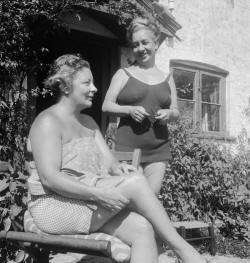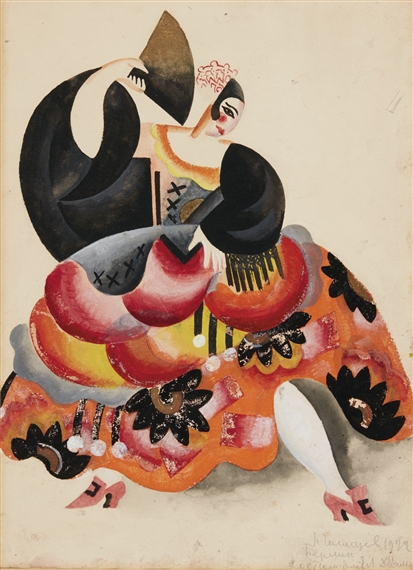Partner Catherine Devilliers,
Poppy Kirk,
Mary Oliver
Queer Places:
29 Rue d'Artois, 75008 Paris, France
376 Rue du Faubourg Saint-Honoré, 75008 Paris, France
4 Savile Row, Mayfair, London W1S, UK
Pembroke Lodge, Richmond Park, Richmond TW10 5HX, UK
 Princess Dilkusha de Rohan (nee Alis Wrench, December 30, 1898, India -
1979, Wyoming) was the founder with
Vera Boréa -
Contessa Boréa de Buzzaccarini Regoli, of a French fashion house in 1931 at
29, rue d'Artois, Paris, one of the first to offer luxury women's sportswear. She was
friends with many artists and writers in London and Paris, including
Janet
Flanner, Dora Maar,
Anna Pavlova,
Pavel Tchelitchew,
Antonina Vallentin,
Dolly
Wilde, and others.
Princess Dilkusha de Rohan (nee Alis Wrench, December 30, 1898, India -
1979, Wyoming) was the founder with
Vera Boréa -
Contessa Boréa de Buzzaccarini Regoli, of a French fashion house in 1931 at
29, rue d'Artois, Paris, one of the first to offer luxury women's sportswear. She was
friends with many artists and writers in London and Paris, including
Janet
Flanner, Dora Maar,
Anna Pavlova,
Pavel Tchelitchew,
Antonina Vallentin,
Dolly
Wilde, and others.
The Princess, daughter of a British Army officer, Major A.T. Wrench, stationed in India,
was educated at Roedean School and married in London on 14 December 1922
Prince Joseph Carlos de Rohan (1895-1931), a German aristocrat, and went to
live with him at Herkules Haus in Charlottenburg, Berlin. The marriage was barely consummated due to her new husband’s homosexuality before Carlos had joined Hitler’s ranks early on.
Dil met and fell in
love with Catherine Devilliers,
known as Katusha, a ballet dancer who had been associated with the Bolshoi
Ballet. Katusha and Dil had been able to live openly together in Berlin during
the 1920s where “they knew the sexual preferences of those who ran the German
armed forces, and later Dil fed those ‘scabrous details’ to Ellic Howe who
organised BBC broadcasts to Hitler’s fighting forces”.
After the Prince was killed in a car accident in 1931 Dilkusha moved to
Paris, where she collaborated with Maximilienne Boréa. The fashion house
remained open at 376, rue Faubourg St Honore until 2007. She became part of
the circle of Alice B. Toklas, who thought her "bawdy" and drank her first and
last Bloody Mary at a birthday party "Dil" gave her.

Photograph of Catherine de Villiers and Princess Dilkusha de Rohan at their Sussex home, Eileen Agar 1899–1991

Photograph of Eileen Agar swimming with Catherine de Villiers and Princess Dilkusha de Rohan in a river in Sussex

Catherine Devilliers

COSTUME DESIGN FOR CATHERINE DEVILLIERS IN SPANISH DANCE AT THE BLAUE VOGEL, 1922

Black and white glass lantern slide of Mary Oliver on a bench

Black and white glass lantern slide of Eileen Agar with Mary Oliver in front of a zebra print rug
In Paris, in 1947, Princess de Rohan invited
Mercedes de Acosta to a dinner
hosted by Maria Annunziata Sartori, better known as
Poppy Kirk. Even though
Princess de Rohan and Kirk had ended their relationship years earlier and had
remained friends, the Princess had invited de Acosta to Kirk's dinner because
she wanted to initiate and affair with de Acosta, instead it was de Acosta and
Kirk that started a lasting relationship.
When Dilkusha later moved to London she established a fashion house with
Nancy Mitford at 4 Savile Row. She lived with her new lover,
Mary Oliver (a
London society hostess who worked for a short time at the ministry; a friend
of Paul and Jane Bowles, she claimed to be an illegitimate child of Gurdjieff,
she was the widow of John Scott “Jock” Oliver (1901– 1938)), and
the art collector Douglas Cooper in a wing of Pembroke Lodge, a
fifty-two-roomed Georgian mansion in Richmond Park.
During the war Princess Dilkusha de Rohan was head of the Swiss desk at the
British Ministry of Information. There she got to know
Guy Burgess and would
later attend the farewell party for him given by
Moura Budberg in 1950 before
he left for Washington, DC.
My published books:


BACK TO HOME PAGE

- That Furious Lesbian: The Story of Mercedes de Acosta
Robert A Schanke
SIU Press, May 10, 2004
- Loving Garbo: The Story of Greta Garbo,Cecil Beaton and Mercedes de Acosta
Hugo Vickers
Random House, Feb 29, 2012
-
https://norman.hrc.utexas.edu/fasearch/findingaid.cfm?eadid=00708
- Double Agent Victoire: Mathilde Carré and the Interallié Network
David Tremain
The History Press, Jun 11, 2018
- Stalin's Englishman: Guy Burgess, the Cold War, and the Cambridge Spy Ring
Andrew Lownie
St. Martin's Publishing Group, Oct 4, 2016
 Princess Dilkusha de Rohan (nee Alis Wrench, December 30, 1898, India -
1979, Wyoming) was the founder with
Vera Boréa -
Contessa Boréa de Buzzaccarini Regoli, of a French fashion house in 1931 at
29, rue d'Artois, Paris, one of the first to offer luxury women's sportswear. She was
friends with many artists and writers in London and Paris, including
Janet
Flanner, Dora Maar,
Anna Pavlova,
Pavel Tchelitchew,
Antonina Vallentin,
Dolly
Wilde, and others.
Princess Dilkusha de Rohan (nee Alis Wrench, December 30, 1898, India -
1979, Wyoming) was the founder with
Vera Boréa -
Contessa Boréa de Buzzaccarini Regoli, of a French fashion house in 1931 at
29, rue d'Artois, Paris, one of the first to offer luxury women's sportswear. She was
friends with many artists and writers in London and Paris, including
Janet
Flanner, Dora Maar,
Anna Pavlova,
Pavel Tchelitchew,
Antonina Vallentin,
Dolly
Wilde, and others. 






